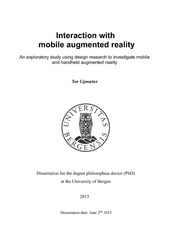| dc.contributor.author | Gjøsæter, Tor | eng |
| dc.date.accessioned | 2015-07-07T11:23:18Z | |
| dc.date.available | 2015-07-07T11:23:18Z | |
| dc.date.issued | 2015-06-02 | |
| dc.identifier.isbn | 978-82-308-2640-9 | |
| dc.identifier.uri | http://hdl.handle.net/1956/10131 | |
| dc.description.abstract | Mobile augmented reality (MAR) has matured significantly over the last two decades, from the conceptual idea of an untethered handheld augmented reality experience in the mid-90s, to prototype technological demonstrations in the early 00s, to actual practical applications in use on smartphones everywhere today. Until recently, the field has been concerned with solving important technical obstacles particular to augmented reality (AR) systems, as well creating systems to augment the world in usable and entertaining ways. To further the understanding of MAR specifically, the concept needs to be seen in its own context through a clear conceptual model and an exploration of how the underlying technology supports the interplay between user and device. MAR systems provide an entirely new point of entry to content such images, videos and 3D information, both in a physical and a technological sense. What content is suitable for this interactive platform and how does the creation of meaning take place in this context? To investigate this type of technology, the specific traits of the system need to be taken into account when gathering data. Similarly, the dissemination of findings about this very visual platform requires a visual language to effectively convey meaning. There are few general design guidelines for MAR that are founded on human computer interaction (HCI) theory and empirical data. Thus, additional domain-specific guidelines must be composed for those designing MAR systems. To approach these issues, this thesis has adopted the design science research (DSR) framework, which provides a set of guidelines for conducting science and research on designed artifacts. This framework also has a strong focus on solving real-world problems and acknowledges artifacts as contributions in themselves. Its guidelines have been used to formulate the problem statements, directing the research design and evaluation as well as the dissemination of findings and results. In conjunction with the overarching guidelines, Think-Aloud (THA) and video recording have been used for evaluation, while user-centered design has served as a foundation specifying the design of the artifacts. A qualitative analysis of the findings has been performed based on theories from HCI. The result of this work is a tangible application that is freely available on the App Store for iOS. Additionally, we present a conceptual model describing handheld mobile augmented reality and an approach to using THA and video recording for evaluation and analysis of MAR systems. A novel approach for illustrative dissemination of findings using the empirical data is described, and general guidelines for MAR systems are presented. Finally, this thesis serves as a guide for conducting similar design science research on AR technology. The contribution of these results is a further understanding of the conceptualization, design, evaluation and dissemination of MAR. | en_US |
| dc.language.iso | eng | eng |
| dc.publisher | The University of Bergen | eng |
| dc.relation.haspart | Paper 1 - T. Gjøsæter, “Computer Supported Collaborative Design Using Augmented Reality,” presented at the SOCINFO ‘09: Proceedings of the 2009 International Workshop on Social Informatics, IEEE Computer Society, 2009. Full-text not available in BORA. The published vesrion is available at: <a href="http://dx.doi.org/10.1109/socinfo.2009.21" target="blank">http://dx.doi.org/10.1109/socinfo.2009.21</a> | eng |
| dc.relation.haspart | Paper 2 - T. Gjøsater, “A taxonomy of handheld augmented reality applications,” presented at the 2012 4th International Conference on Intelligent Human Computer Interaction (IHCI), 2012, pp. 1–6. Full-text not available in BORA. The published vesrion is available at: <a href="http://dx.doi.org/10.1109/ihci.2012.6481781" target="blank">http://dx.doi.org/10.1109/ihci.2012.6481781</a> | eng |
| dc.relation.haspart | Paper 3 - T. Gjøsæter and K. Jørgensen, “Combining Think Aloud and Comic Strip Illustration in the Study of Augmented Reality Games” presented at the NOKOBIT 2012, 2012, pp. 77–90. Full-text not available in BORA. | eng |
| dc.relation.haspart | Paper 4 - T. Gjøsæter, “Affordances in Mobile Augmented Reality Applications,” International Journal of Interactive Mobile Technologies (iJIM) Vol 8, No 4, 2014 pp. 45-55. The paper is available here: <a href="http://hdl.handle.net/1956/10132" target="blank">http://hdl.handle.net/1956/10132</a> | eng |
| dc.rights | All rights reserved. | eng |
| dc.title | Interaction with mobile augmented reality: An exploratory study using design research to investigate mobile and handheld augmented reality | eng |
| dc.type | Doctoral thesis | en_US |
| dc.rights.holder | Copyright the author. | en_US |
| dc.subject.nsi | VDP::Matematikk og Naturvitenskap: 400::Informasjons- og kommunikasjonsvitenskap: 420 | no |
| dc.subject.nsi | VDP::Samfunnsvitenskap: 200::Biblioteks- og informasjonsvitenskap: 320::Informasjons- og kommunikasjonssystemer: 321 | no |
